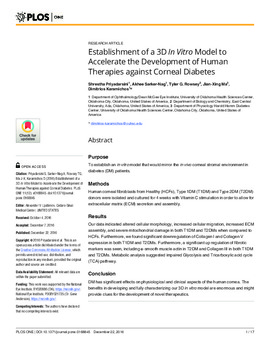| dc.contributor.author | Shrestha Priyadarsini | |
| dc.contributor.author | Akhee Sarker-Nag | |
| dc.contributor.author | Tyler G. Rowsey | |
| dc.contributor.author | Jian-Xing Ma | |
| dc.contributor.author | Dimitrios Karamichos | |
| dc.date.accessioned | 2017-03-05T23:41:01Z | |
| dc.date.available | 2017-03-05T23:41:01Z | |
| dc.date.issued | 2016-12-22 | |
| dc.identifier.citation | Priyadarsini S, Sarker-Nag A, Rowsey TG, Ma J-X, Karamichos D (2016) Establishment of a 3D In Vitro Model to Accelerate the Development of Human Therapies against Corneal Diabetes. PLoS ONE 11(12): e0168845. doi:10.1371/journal.pone.0168845 | en_US |
| dc.identifier.uri | https://hdl.handle.net/11244/49299 | |
| dc.description | The authors thank Dr. John M Asara, Min Yuan, and Susanne Breitkopf for their technical help with metabolomics experiments, Dr. Ben Fowler for his technical help with TEM experiments and also Tina B McKay for many thoughtful discussions and scientific insights during the study. | en_US |
| dc.description | | en_US |
| dc.description.abstract | Purpose To establish an in vitro model that would mirror the in vivo corneal stromal environment in diabetes (DM) patients. Methods Human corneal fibroblasts from Healthy (HCFs), Type 1DM (T1DM) and Type 2DM (T2DM) donors were isolated and cultured for 4 weeks with Vitamin C stimulation in order to allow for extracellular matrix (ECM) secretion and assembly. Results Our data indicated altered cellular morphology, increased cellular migration, increased ECM assembly, and severe mitochondrial damage in both T1DM and T2DMs when compared to HCFs. Furthermore, we found significant downregulation of Collagen I and Collagen V expression in both T1DM and T2DMs. Furthermore, a significant up regulation of fibrotic markers was seen, including α-smooth muscle actin in T2DM and Collagen III in both T1DM and T2DMs. Metabolic analysis suggested impaired Glycolysis and Tricarboxylic acid cycle (TCA) pathway. Conclusion DM has significant effects on physiological and clinical aspects of the human cornea. The benefits in developing and fully characterizing our 3D in vitro model are enormous and might provide clues for the development of novel therapeutics. | en_US |
| dc.language.iso | en_US | en_US |
| dc.publisher | PLos One | |
| dc.relation.ispartofseries | PLoS ONE 11(12): e0168845 | |
| dc.relation.uri | http://www.plosone.org/article/info%3Adoi%2F10.1371%2Fjournal.pone.0168845 | |
| dc.rights | Attribution 3.0 United States | |
| dc.rights.uri | https://creativecommons.org/licenses/by/3.0/us/ | |
| dc.subject | Cornea,Diabetes mellitus,Mitochondria,Collagens,Gene expression,Glucose metabolism,Cell migration,Glycolysis | en_US |
| dc.title | Establishment of a 3D In Vitro Model to Accelerate the Development of Human Therapies against Corneal Diabetes | en_US |
| dc.type | Research Article | en_US |
| dc.description.peerreview | Yes | en_US |
| dc.description.peerreviewnotes | http://www.plosone.org/static/editorial#peer | en_US |
| dc.identifier.doi | 10.1371/journal.pone.0168845 | en_US |
| dc.rights.requestable | false | en_US |

